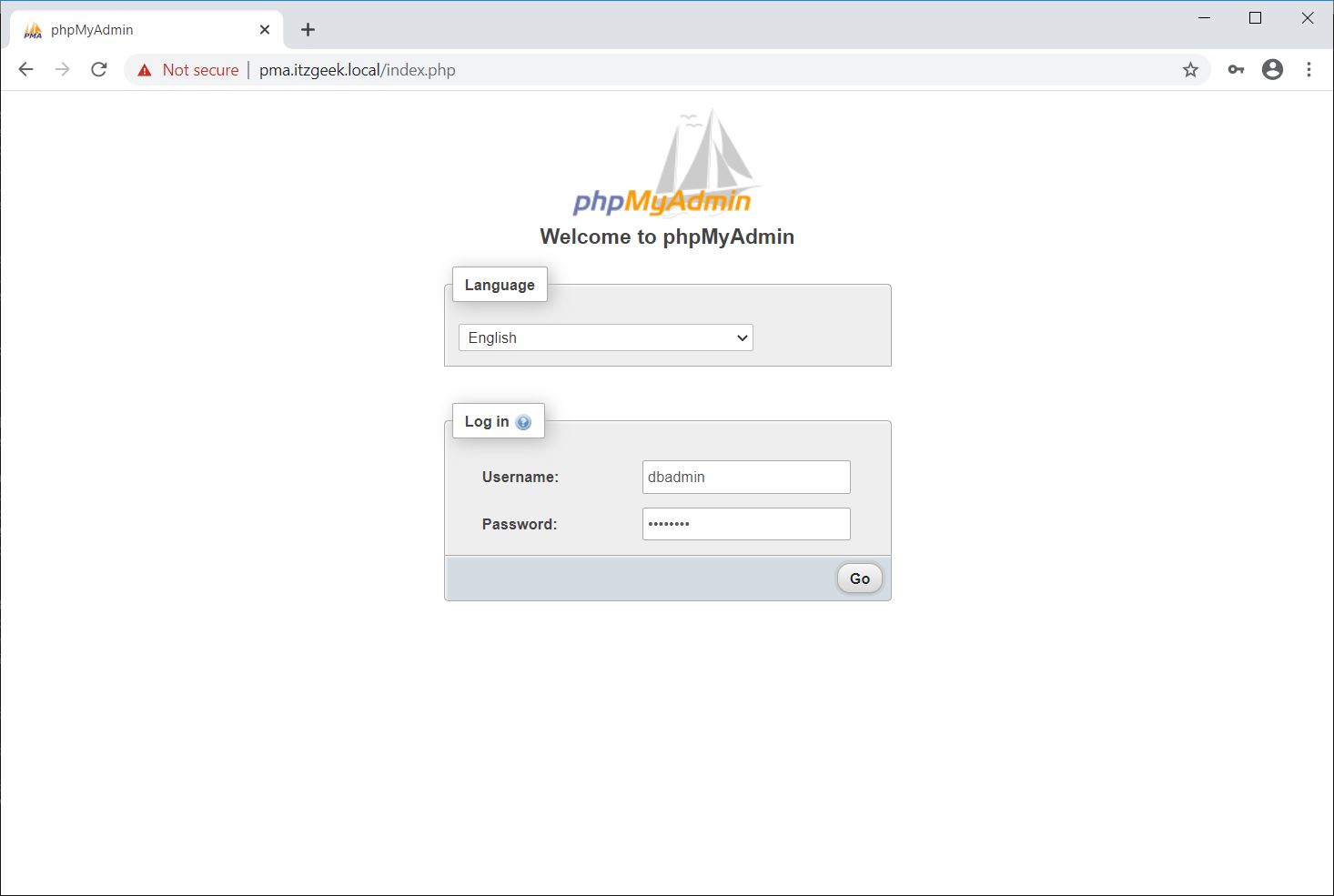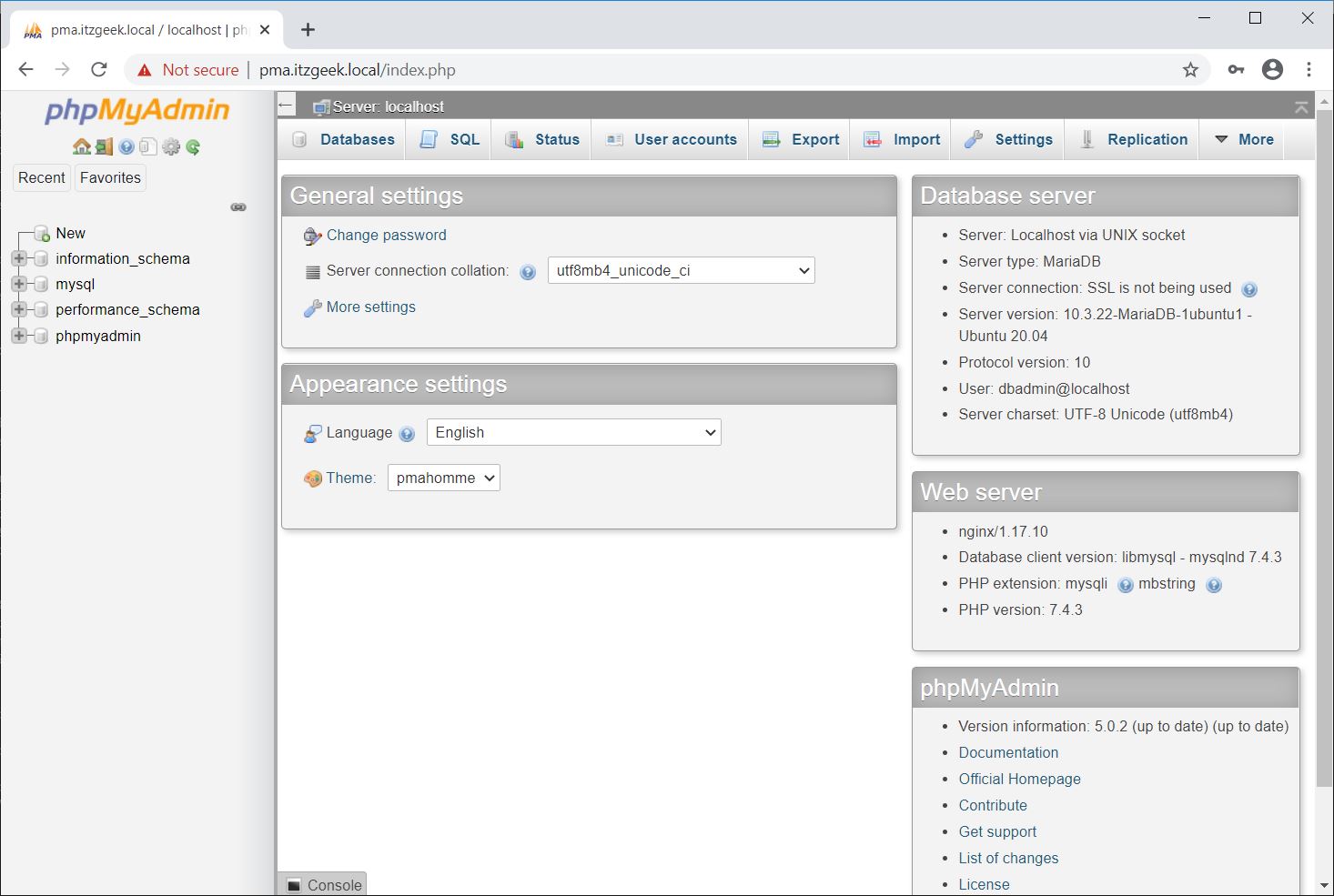How To Install phpMyAdmin with Nginx on Ubuntu 20.04 | Holhol24
phpMyAdmin is a free and open-source web interface for managing
MySQL and
MariaDB servers. It is widely used by web hosting companies to enable website owners to create and manage databases on their own.
phpMyAdmin helps us to perform database activities such as creating, deleting, querying, database, tables, columns, etc.
In this post, we will see how to install
phpMyAdmin with Nginx on
Ubuntu 20.04.
Prerequisites
Install MariaDB Server
To manage databases with phpMyAdmin, your system must have a database instance running and the
Nginx web server.
Standalone Database
Follow the below tutorials and prepare your system for setting up phpMyAdmin.
Step 1:
How To Install MariaDB on Ubuntu 20.04
OR
Step 1:
How To Install MySQL 8.0 on Ubuntu 20.04
Then,
Step 2:
How To Install LEMP Stack on Ubuntu 20.04
You can skip the installation of the MariaDB server in Step 2 – LEMP stack tutorial if you have followed Step 1 – MariaDB/MySQL installation.
Install the below PHP extensions for phpMyAdmin to connect with the database.
sudo apt install -y php-json php-mbstring
LEMP Stack
READ:
How To Install LEMP Stack on Ubuntu 20.04
Install the below PHP extensions for phpMyAdmin to connect with the database.
sudo apt install -y php-json php-mbstring
Install phpMyAdmin
The phpMyAdmin available in the Ubuntu OS repository for Ubuntu 20.04 is a bit old. So, we will download the latest version of phpMyAdmin from the
official website.
wget https://files.phpmyadmin.net/phpMyAdmin/5.0.2/phpMyAdmin-5.0.2-all-languages.tar.gz
Extract phpMyAdmin using the
tar command.
tar -zxvf phpMyAdmin-5.0.2-all-languages.tar.gz
Move the phpMyAdmin to your desired location.
sudo mv phpMyAdmin-5.0.2-all-languages /usr/share/phpMyAdmin
Configure phpMyAdmin
Copy the sample configuration file.
sudo cp -pr /usr/share/phpMyAdmin/config.sample.inc.php /usr/share/phpMyAdmin/config.inc.php
Edit the configuration file.
sudo nano /usr/share/phpMyAdmin/config.inc.php
Generate a
blowfish secret code and update the secret in the configuration file.
$cfg['blowfish_secret'] = 'CfX1la/aG83gx1{7rADus,iqz8RzeV8x'; /* YOU MUST FILL IN THIS FOR COOKIE AUTH! */
Also, uncomment the phpMyAdmin storage settings.
Change the controluser and controlpass with your user and password who have access to phpMyAdmin’s configuration database which we will create in the next step. This user account is used to access phpMyAdmin configuration storage.
/** * phpMyAdmin configuration storage settings. */ /* User used to manipulate with storage */ $cfg['Servers'][$i]['controlhost'] = 'localhost'; // $cfg['Servers'][$i]['controlport'] = ''; $cfg['Servers'][$i]['controluser'] = 'pma'; $cfg['Servers'][$i]['controlpass'] = 'pmapass'; /* Storage database and tables */ $cfg['Servers'][$i]['pmadb'] = 'phpmyadmin'; $cfg['Servers'][$i]['bookmarktable'] = 'pma__bookmark'; $cfg['Servers'][$i]['relation'] = 'pma__relation'; $cfg['Servers'][$i]['table_info'] = 'pma__table_info'; $cfg['Servers'][$i]['table_coords'] = 'pma__table_coords'; $cfg['Servers'][$i]['pdf_pages'] = 'pma__pdf_pages'; $cfg['Servers'][$i]['column_info'] = 'pma__column_info'; $cfg['Servers'][$i]['history'] = 'pma__history'; $cfg['Servers'][$i]['table_uiprefs'] = 'pma__table_uiprefs'; $cfg['Servers'][$i]['tracking'] = 'pma__tracking'; $cfg['Servers'][$i]['userconfig'] = 'pma__userconfig'; $cfg['Servers'][$i]['recent'] = 'pma__recent'; $cfg['Servers'][$i]['favorite'] = 'pma__favorite'; $cfg['Servers'][$i]['users'] = 'pma__users'; $cfg['Servers'][$i]['usergroups'] = 'pma__usergroups'; $cfg['Servers'][$i]['navigationhiding'] = 'pma__navigationhiding'; $cfg['Servers'][$i]['savedsearches'] = 'pma__savedsearches'; $cfg['Servers'][$i]['central_columns'] = 'pma__central_columns'; $cfg['Servers'][$i]['designer_settings'] = 'pma__designer_settings'; $cfg['Servers'][$i]['export_templates'] = 'pma__export_templates';
Credit:
TECHIES WORLD
Import the create_tables.sql to create tables for phpMyAdmin.
sudo mysql < /usr/share/phpMyAdmin/sql/create_tables.sql -u root -p
Login to MariaDB.
sudo mysql -u root -p
Add the user and grant permission to phpMyAdmin’s configuration database.
CREATE USER 'pma'@'localhost' IDENTIFIED BY 'pmapass'; GRANT ALL ON phpmyadmin.* TO 'pma'@'localhost'; FLUSH PRIVILEGES; exit
Create a virtual host configuration file for phpMyAdmin under the /etc/nginx/conf.d directory.
sudo nano /etc/nginx/conf.d/phpMyAdmin.conf
Use the following server block to create a virtual host for phpMyAdmin. Change the domain name (server_name) as per your requirement.
server {
listen 80;
server_name pma.holhol24.local;
root /usr/share/phpMyAdmin;
location / {
index index.php;
}
## Images and static content is treated different
location ~* ^.+.(jpg|jpeg|gif|css|png|js|ico|xml)$ {
access_log off;
expires 30d;
}
location ~ /.ht {
deny all;
}
location ~ /(libraries|setup/frames|setup/libs) {
deny all;
return 404;
}
location ~ .php$ {
include /etc/nginx/fastcgi_params;
fastcgi_pass 127.0.0.1:9000;
fastcgi_index index.php;
fastcgi_param SCRIPT_FILENAME /usr/share/phpMyAdmin$fastcgi_script_name;
}
}
Create a tmp directory for phpMyAdmin and then change the permission.
sudo mkdir /usr/share/phpMyAdmin/tmp
sudo chmod 777 /usr/share/phpMyAdmin/tmp
Set the ownership of the phpMyAdmin directory.
sudo chown -R www-data:www-data /usr/share/phpMyAdmin
Restart the services.
sudo systemctl restart nginx
sudo systemctl restart php7.4-fpm
Create DB Admin User
By default, MariaDB root user is allowed to log in only via the Unix socket. So, we will now create a database administrative user with permission to manage all databases.
GRANT ALL PRIVILEGES ON *.* TO 'dbadmin'@'localhost' IDENTIFIED BY 'password'; FLUSH PRIVILEGES; EXIT;
If required, you can
disable Unix socket authentication for MariaDB root user and enable native password login.
Access phpMyAdmin
Access the phpMyAdmin using the
web browser:
http://your-fully-qualified-domain-name
Log in with database admin user we just created in the previous step.

You will get the home page where you can manage databases.

Conclusion
That’s All. I hope this post helped you to install
phpMyAdmin with
Nginx on
Ubuntu 20.04. Please share your feedback in the comments section.
